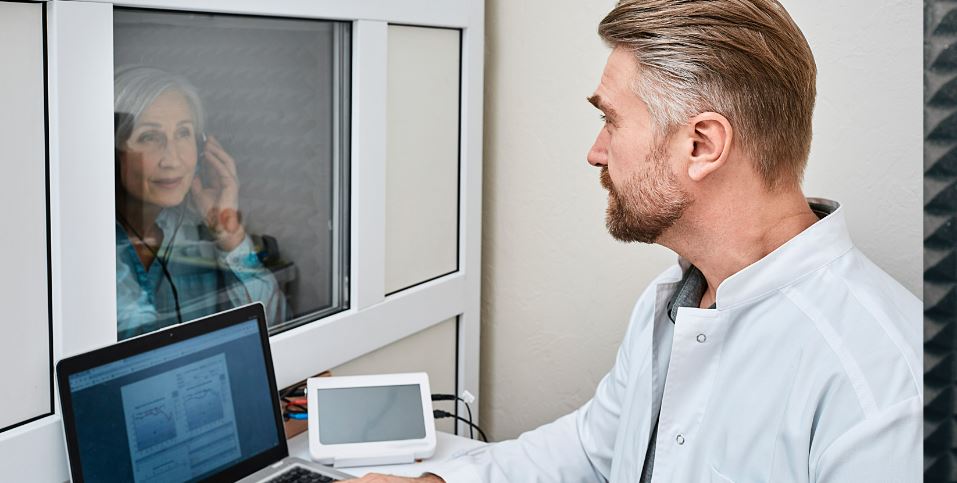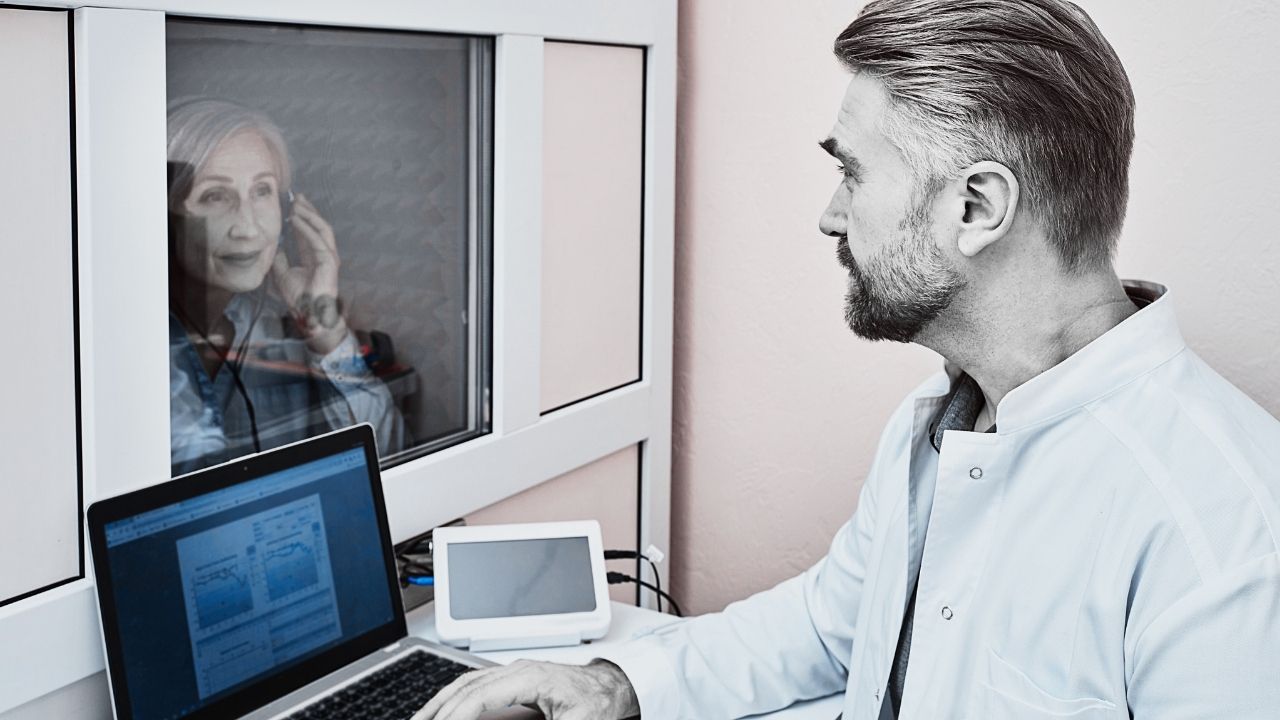This blog is another in a series of historical vignettes in audiology authored under the direction of Dr. Frank Musiek at the University of Connecticut, Storrs, CT. These provide not only an historical contribution, but relate how this information and testing continues to have application today, but one might have to use their imagination.
–Wayne Staab, PhD
by Frank Musiek, Au.D. Ph.D. and Christopher Herget, B.S.
Neuroaudiology Lab, University of Connecticut
In 1959, an article was published in the Archives of Otolaryngology by Jerger, Shedd and Harford that would have a profound effect on diagnostic audiology. The focus of the article was on a test procedure that would help differentiate cochlear from retrocochlear lesions. The test was called the short increment sensitivity index or (as it became well known as) the SISI. Then as it is today, the identification of eighth nerve involvement, in particular acoustic neuromas, was an important challenge for the audiologist and otologist.
Therefore there was, from the outset, considerable interest in the SISI. In addition, this new test chronologically came on the heels of the Carhart threshold tone decay test, which also was receiving considerable attention as a technique to identify eighth nerve dysfunction. Therefore at this time, many hearing healthcare professionals were becoming highly sensitive to the diagnostic potential of these new audiological tests. It was clear that audiology was gaining professional respect and making it’s way into both the fields of audiology and otology.
The SISI test’s heritage is interesting, yet logical. The SISI is essentially a difference limen (DL) for intensity discrimination and early research on intensity discrimination served as a critical forerunner to this procedure. In fact, Jim Jerger’s master’s thesis was on the topic of intensity discrimination and was published in 1952.
In the late 1940s and into the 1950s many hearing researchers were looking into intensity difference limens as a possible way to help define cochlear dysfunction.
The research at this time seemed to be moving in the direction of associating smaller than normal DLs with cochlear involvement. However, in 1954, Hirsh, Palva and Goodman published their research which threw a wrench into the intensity DL movement. These investigators argued through their research that the intensity DL were no different for normal hearing individuals then those with cochlear hearing loss. This finding triggered considerable debate and discussion. In fact, much of this debate involved psychoacousticians and audiologists and did much to enhance our knowledge about intensity discrimination and it’s clinical application.
Despite the Hirsh and colleagues article the idea of using intensity discrimination as a site of lesion test continued to gain interest albeit a bit slower.

The SISI Procedure
Measures of auditory discrimination can be administered in a variety of ways (see Gelfand 2009) and Olsen and Matkin (1978) for reviews. In our view there are three classic methodologies:
- The memory
- The modulation
- The masking procedure
The SISI is essentially a masking intensity discrimination measure. This technique requires the generation of a continuous tone that increases in intensity a selected amount at a selected point in time. The SISI has intensity increments of 5 dB, 2 dB and 1 dB with only the 1 dB changes counting as the actual test. The increment in intensity, which is superimposed on a continuous tone, is 300 msec in total duration with a 50 msec rise – fall time. There have been some modifications of the SISI by different investigators
The patient is instructed that they will hear a tone that will change in intensity. The patient should count how many times the tone changes in intensity, no matter how much of a change it may be. The audiologist then presents a 20 dB SL tone, typically at 1000 and 4000Hz, adjusting the intensity between 1 and 5 dB every five seconds. Even though the SISI requires two intensity level changes, (1 and 5dB) the SISI test is measured only in 1 dB increments. The 5dB increase in intensity has two main functions, which are to initially condition the subject. By presenting several 5dB increases at the beginning of the test, it provides a sampling of the test procedure to the subject. The other function is to maintain the attention of the subject throughout the test. This is done by equally spacing the 5dB signals throughout the test, (typically after the 11th, 17th and 23rd 1-dB increases). After twenty 1 dB increases are presented, the test is completed and the final score calculated.
The score is calculated by multiplying the number of correct 1 dB increases by 5, which will provide a percentage. A percentage score between 0 and 70% is considered “negative for cochlear pathology conditions” and a score of 75% or above is considered “positive for cochlear pathology conditions”. Extremely low scores (<20 %) were considered by some researchers as a retrocochlear sign, however this failed to gain popularity. Modifications of the SISI test include reducing the step size between the conditional intensity (5 dB) and the measurable intensity (1 dB). This will allow the patient to condition more effectively to the softer change in intensity which may increase patient attention to the task, reducing the test time overall.

Impact on Diagnostic Audiology
The SISI test was developed on the heels of Carhart’s threshold tone decay test. These events shook both the audiological and otological world in that diagnostic procedures were beginning to find their place in the clinic and in the research labs.
The advent of the Carhart tone decay and SISI procedures heralded the use of these tests to differentiate cochlear from retrocochlear site of lesion –a critical advance. A firestorm resulted in interest of these tests as well as this new area of diagnostic audiology, due to the status of Jerger and Carhart in the audiology community and their clinical utility. The SISI certainly ushered in a new era of audiology. Using sound to probe the disorders of the auditory system was pivotal and would make audiology what it is today.
For many years after the 1959 paper, research on the SISI dominated the clinical research in audiology. SISI modifications of all sorts were introduced, investigated, analyzed, and debated. The result of all this activity regarding the SISI was huge advances in his new area of diagnostic audiology. These advances not only were within the field of audiology but also across other disciplines.
Otologists began to realize the value of diagnostic audiology and the diagnostic audiologist. Therefore it could be said that the SISI test impact on audiology was far beyond just the test alone, it created a diagnostic movement.
Potential Use Today
In today’s audiology the SISI test is seldom utilized; other tests such as the acoustic reflex, ABR and otoacoustic emissions have taken its place in the diagnostic test battery. However, there still may be a use for the SISI test. One of the glaring weaknesses in clinical audiology today is that there is no measure of auditory discrimination whether it be for intensity, frequency or duration of sound events. The SISI test is, by it’s nature, a measure of intensity discrimination. In fact, as stated earlier, the SISI test is a masking discrimination measure —one of the accepted psychoacoustic procedures for measuring auditory discrimination (Moore). Since such a measure is not available in audiology one may consider the SISI as a test of intensity discrimination.
Studies comparing the SISI test with other auditory discrimination procedures may be worthwhile. If it compares well, it would be highly clinically useful. The SISI requires little time, is dependable, and has an extensive clinical track record.
Who knows, with a little research perhaps the SISI will become utilized again.
References:
- Jerger, J., Shedd, J. and Harford, E. 1959; On the detection of extremely small changes in sound intensity. Archives of Otolaryngology, 1959; 69:200-211.
- Jerger, J. A difference limen recruitment test and it’s diagnostic significance. Laryngoscope, 1952; 62:1316 – 1332.
- Hirsh, I., Palva, T., and Goodman, A. Difference limen and recruitment. Archives of Otolaryngology, 1954; Vol. 60:525 – 540.
- Gelfand, S. Essentials of Audiology. (3rd Edition). 2009. New York, NY: Thieme.
- Olsen, W. and Matkin, N. Differential Audiology, In: (Ed.) Rose, D. , Audiological Assessment, Prentice – Hall, Engle Wood Cliffs, NJ, 1978. pp 378-379
- Gelfand, S. 2009. Essentials of Audiology. (3rd Edition). New York, NY: Thieme.
- Roeser R, Valente M, Hosford-Dunn H. (Eds). Audiology: Diagnosis (2nd Edition). Thieme Medical Publishers, New York, 2007.
- Moore DR (2007). Auditory processing disorders: acquisition and treatment. J Commun Disord 40 (4): 295–304.







